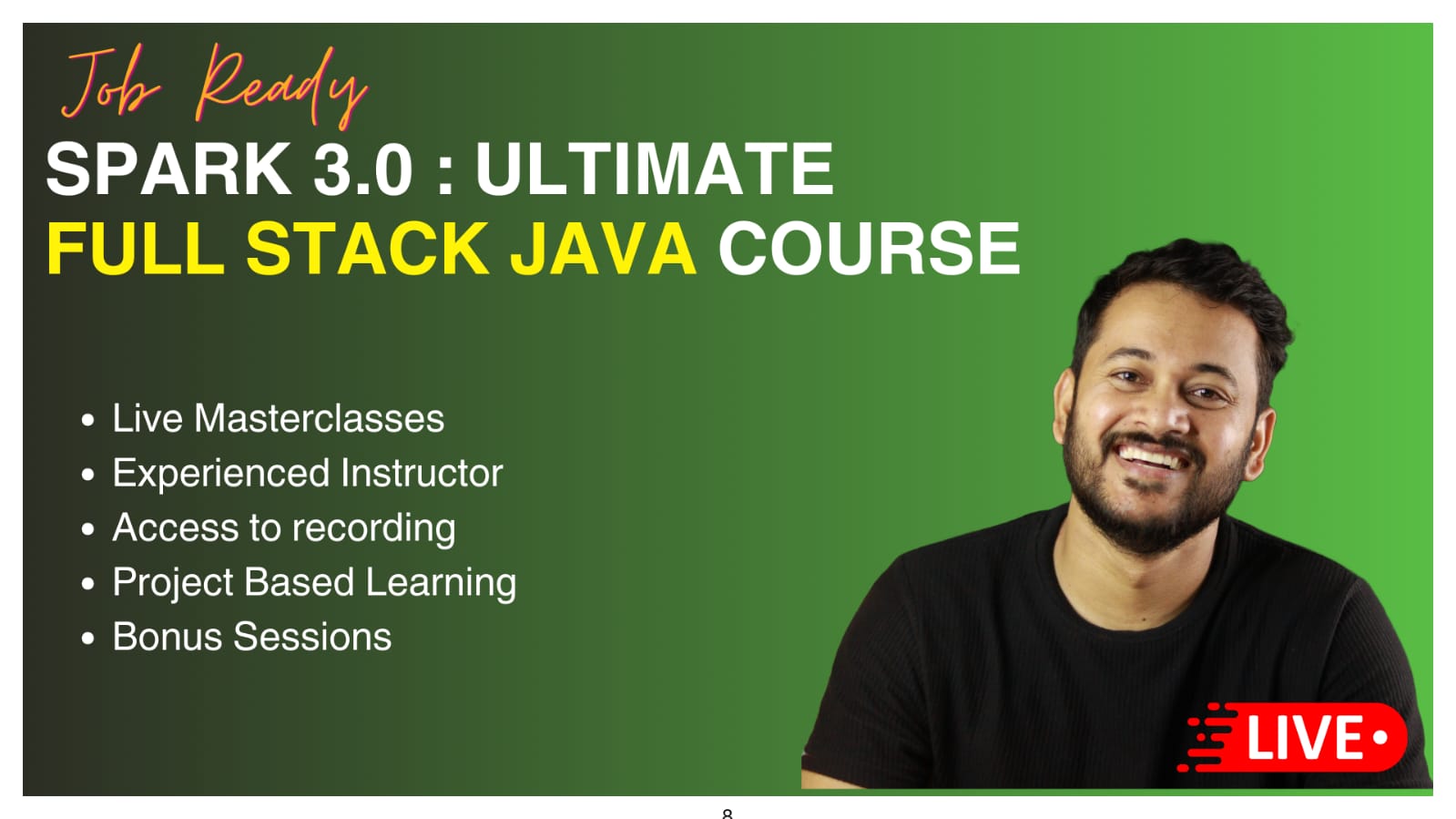- Real time projects
- 120 + hours of core teaching
- Certificate of completion
- Bonus sessions
- Weekend sessions
- Resume assistance
- Live Doubts clearing session
- Access to recordings
Course Details
-
Course Starts
1st Jan 2025
-
Course Duration
4+ MONTHS
-
Class Timings
[9:00AM - 12:00PM] Live Teaching on Weekends
-
Class Duration
3+ Hours Live Teaching
-
Class Recording Provided
Yes
-
Course Validity
2 year
-
Programming Language Used
Java
-
Prerequisite
No Prerequisites (Beginner Friendly)
What you'll learn
- Spring Framework Core Features: Master Spring IOC Container, Beans, and AutoConfigurations
- Learn Spring Framework fundamentals from scratch—no prior experience needed
- Comprehensive Coverage of Dependency Injection
- In-depth Understanding of Spring MVC Concepts
- Explore Spring Boot Internals, Spring Initializr, and Starter Projects
- Simplify your Java code with Lombok
- Setting up an In-Memory Database with H2 DB
- Robust Spring Bean Data Validation Techniques
- Effective Exception Handling in Spring Boot Applications
- Polishing Response Objects for Professional API Outputs
- Building REST APIs with Spring Boot—Simplified
- Hands-on Mini Project: Develop Restful Web Services
- Mastering Spring Data JPA: From Basics to Advanced Custom Queries with MySQL and PostgreSQL
- Configuring Hibernate ORM with JDBC
- Utilizing Spring Data JPA Query Methods
- Implementing DTO Patterns and Using Mapping Libraries
- Monitoring Applications with Spring Boot Actuator
- Creating Comprehensive Documentation with Swagger and Open API
- Boosting Development Efficiency with Spring Dev Tools
- Implementing Effective Logging Strategies
- Integrating Third-Party APIs with REST Template
- Securing REST APIs with Spring Security 6 and SQL Database
- Developing a Registration and Login System with Spring MVC, Spring Boot, Spring Data JPA, and MySQL
- Implementing Third-Party Registration with Google OAuth and JWT Authentication
- Role-Based Access Control with Spring Boot Authorization and SQL Database
- Fine-Tuning Roles and Permissions, Securing Methods, and Customizing Error Pages
- Safeguarding Passwords with Secure Encoding
- Testing with JUnit and Assert Methods
- Conducting Integration Tests for Reactive CRUD REST APIs
- Advanced Unit Testing with Mockito
- Managing Different Environments using Spring Profiles
- Understanding Aspect-Oriented Programming
- Implementing Various Advice Types: Before, After, and After Throwing Advice
- Enhancing Cache Performance with Redis Spring Cache
- Implementing Publish/Subscribe Messaging with Redis
- Leveraging Apache Kafka in Spring Boot
- Understanding Kafka Architecture
- Developing Kafka Publishers and Consumers
- Utilizing Spring Cloud Stream with Kafka Binder
- Comprehensive Introduction to Microservices
- Comparing Monolithic and Microservice Architectures
- Key Principles and Advantages of Microservices
- Creating REST APIs in a Microservice Architecture
- Microservices Communication with RestTemplate, WebClient, and Cloud OpenFeign
- Service Registry and Discovery using Spring Cloud Netflix Eureka
- Implementing API Gateway using Spring Cloud Gateway
- Auto-Refreshing Configuration Changes with Spring Cloud Bus
- Securing Microservices with JWT
- Centralized Configuration Management with Spring Cloud Config Server
- Docker Setup and Command Mastery
- Step-by-Step Dockering of Spring Boot Applications
- Understanding Docker’s Role in Microservices Deployment
- Orchestrating Multi-Container Applications with Docker Compose
Course Curriculum
-
Overview of Java and its history
-
Setting up the Java development environment (JDK, IDE)
-
Writing your first "Hello, World!" program
-
Understanding Java's syntax and structure
-
Declaring and using variables
-
Primitive data types (int, double, char, etc.)
-
Arithmetic, relational, and logical operators
-
Conditional statements (if, else if, switch)
-
Looping structures (for, while, do-while)
-
Exception handling (try-catch, throw, throws)
-
HTML, CSS, JS
-
Defining classes and objects
-
Constructors and methods
-
Encapsulation and access modifiers
-
Inheritance and the "is-a" relationship
-
Method overriding
-
Abstract classes and interfaces
-
Question On OOPs Concepts
-
Introduction to Multithreading
-
Basics of Threads
-
Thread Synchronization
-
Inter-thread Communication
-
Thread Safety
-
Advanced Synchronization
-
Thread Pools and Executors
-
Best Practices and Patterns
-
Real-world Applications
-
Working with collections (ArrayList, HashMap, etc.)
-
Working of HashMap
-
Iteration and manipulation of collections
-
Introduction to generics
-
Advanced data structure discussions and coding challenges
-
Understanding Where to use which Collection
-
Java 8 API Introductio
-
Stream
-
Lambda Expression
-
Introduction to Exceptions
-
Exception Hierarchy
-
Handling Exceptions
-
The finally Block
-
Exception Propagation
-
Custom Exceptions
-
Best Practices in Exception Handling
-
Exception Handling in Real-world Applications
-
Basics of relational databases
-
Introduction to SQL
-
Installing a database server
-
Setting up JDBC drivers
-
Establishing database connections
-
Executing SQL queries and updates
-
Using prepared statements to prevent SQL injection
-
Managing transactions in JDBC
-
Overview of web development and the role of servlets.
-
Setting up the development environment (IDE, JDK).
-
Creating your first servlet and deploying it.
-
Understanding the servlet life cycle.
-
Handling HTTP GET and POST requests.
-
Accessing request parameters and headers.
-
Managing user sessions in servlets.
-
Using cookies for session tracking.
-
Best practices for session management.
-
Understanding servlet filters.
-
Implementing request and response filters.
-
Event listeners in servlets.
-
Exception handling in servlets.
-
Deploying servlets to a web server (e.g., Apache Tomcat).
-
Testing and debugging servlets.
-
Processing form submissions in servlets.
-
Validating user input.
-
Form design best practices.
-
Advanced session management techniques.
-
Implementing user authentication and authorization.
-
Securing web applications.
-
Connecting to a database using JDBC.
-
Performing database operations in servlets and JSP.
-
Displaying database content in web applications.
-
Introduction to the Model-View-Controller (MVC) pattern.
-
Implementing MVC architecture in a web application.
-
Separating concerns for maintainable code.
-
Check one project (e.g., a simple web application).
-
Implementing all the concepts learned in the course.
-
Introduction to React
-
Setting Up the React Environment
-
Introduction to JSX and how it differs from HTML
-
React Components
-
Types of Components: Functional and Class
-
Props in React and how to pass data between components
-
State in React and how it manages dynamic data
-
Event Handling in React
-
Conditional Rendering using State and Props
-
Working with Forms in React: Controlled vs. Uncontrolled Components
-
Hands-on Practice: One project using all the above concepts
-
Introduction to React Router and its importance in SPA development
-
Understanding Route
-
Nested Routing and Route Parameters
-
API Integration with React
-
Managing Asynchronous Data and Promises
-
Error Handling: Managing UI for errors and loading states
-
Optimization Techniques: Lazy Loading and Code Splitting
-
Hands-on Practice: One project integrating routing and API calls
-
Overview of the Spring framework and its components.
-
Setting up the development environment (IDE, JDK).
-
Creating a basic Spring project.
-
Understanding Inversion of Control (IoC).
-
Configuring and using the Spring IoC container.
-
Dependency Injection (DI) and autowiring.
-
Defining beans in the Spring context.
-
Understanding different bean scopes (singleton, prototype, etc.).
-
Working with bean initialization and destruction.
-
What is Spring Boot and its advantages?
-
Creating a basic Spring Boot application.
-
Spring Boot auto-configuration and starters.
-
Developing RESTful APIs with Spring Boot.
-
Handling HTTP requests and responses.
-
Testing APIs with tools like Postman.
-
Introduction to Spring Data JPA.
-
Connecting to a database.
-
Creating and using repositories.
-
Developing web applications with Spring Boot.
-
Why Spring Boot Needed
-
Securing Spring Boot applications with Spring Security.
-
Deploying Spring Boot applications to a server.
-
Monitoring and managing Spring Boot applications
-
Understanding profiles in Spring Boot.
-
Externalizing configuration with properties files.
-
Spring Boot profiles for different environments.
-
Understanding Docker Fundamentals.
-
Docker in Real-World.
-
Why Do We Need Docker ?
-
All About Docker Images And Container
-
Building Docker Images
-
Running Docker Containers
-
Running Spring Boot Application As Docker Container
-
Understanding Why Microservices needed
-
Microservices Vs Monolithic
-
Architecture of Microservices
-
Understanding Microservices Component
-
What are microservices?
-
Advantages and disadvantages
-
Key principles and design patterns
-
What is REST?
-
Key principles and constraints
-
Understanding HTTP methods (GET, POST, PUT, DELETE)
-
Request and response structure
-
Creating a basic RESTful API
-
Identifying resources
-
URI design and naming conventions
-
Mapping HTTP methods to CRUD operations
-
Data serialization (JSON, XML)
-
Handling different content types
-
HTTP status codes for API responses
-
Implementing error handling in APIs
-
API versioning strategies
-
API documentation tools and best practices
-
Learning All About POSTMAN
-
Learning ALL About MAVEN
-
Learning ALL ABOUT GIT
-
Understanding Kafka
-
Setting Up Kafka with Docker
-
Why Do We Need Kafka ?
-
Producing and Consuming Messages
-
Communication between two microservices using Kafka
-
Advanced Kafka Concepts
-
Kafka in Real-world Applications
-
Hotstar And Zomato Application Simulation
-
Week 1: Core Java + Advance Java Interviews
-
Spring Core + Spring Boot Interviews
-
Spring Framework + Microservices Interview
-
Interviews(Combined All Topics)
-
Hotel Reservation System With [LLD+HLD]
-
Online Parking System With [LLD+HLD]
-
Covid Data Tracker With [LLD+HLD]
-
Weather Application
-
Hotstar Application With [LLD + HLD]
-
E-commerce Application
-
Quiz Application
-
Google Doc Backend
-
BookMyShow Backend
-
And ManyMore
What you'll Build
React
Create Web applications using React.
Spring-based Applications
Create robust applications using Spring Framework core features.
Real-time Projects
Gain hands-on experience through real-time projects.
REST APIs
Develop and secure RESTful APIs with Spring Boot.
Projects
Complete a project involving Restful Web Services.
Database Integration
Set up and integrate in-memory databases with H2 DB.
Spring Data JPA Applications
Build applications utilizing Spring Data JPA with MySQL and PostgreSQL.
Custom Queries
Implement custom queries using Spring Data JPA.
Exception Handling Mechanisms
Design and implement robust exception handling in your applications.
Role-based Access Control
Implement fine-tuned roles and permissions.
Microservices
Develop microservices architecture applications.
Bonuses
Tools you will learn
Get Certified from Code For Success

Frequently Asked Questions
While we provide comprehensive training and support, job placement ultimately depends on your skills and efforts. We'll equip you with the knowledge and tools you need to pursue a career in your chosen field.
Yes, our course includes hands-on project training to provide you with practical experience in applying the concepts you learn.
The highest package our students have received varies from year to year. We have had students achieve competitive packages in leading companies.
The duration required to secure a job may vary based on individual factors. Our course is designed to provide you with the necessary skills and knowledge, but your success in the job market depends on various factors, including your prior experience and job market conditions.
Absolutely! Our course is suitable for both freshers and professionals looking to enhance their skills in the field.
Yes, we provide access to course recordings for your convenience, ensuring you can review the material at your own pace.
Yes, you will receive a certificate of completion to showcase your achievement in the course.
The primary language of our course is java
Community support refers to our commitment to creating a supportive network of students and alumni who can connect, share insights, and provide assistance to one another through forums, social media, and other platforms.
After signup and enrollment, click on the discussions button to ask questions to me and others who are doing the course. You will also get access to my exclusive Telegram Group
After payment, you will receive instructions on how to access the course materials and get started with your learning journey.
We encourage open communication. If you have any queries or feedback, feel free to contact us at write2codeforsuccess@gmail.com, and we'll be happy to assist you.
You can also connect with us on Telegram and discord.


